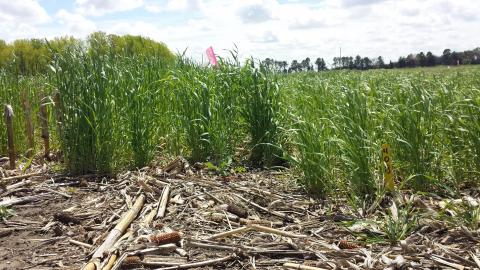Cover Crop Productivity In Corn And Soybean Systems
September 7, 2017
University researchers share results from their study of cover crops planted pre- and post-harvest and in seed corn at three sites: Clay Center, Concord, and Mead.
2017 Corn Yield Forecasts as of August 30
September 1, 2017
Forecasts for end-of-season corn yields improved across much of the Corn Belt since the early August forecast. View crop stage and yield forecasts as well as weather data. In Nebraska predictions are for near to above average corn yields for most sites, except northeast and northwest sites.
Estimating Potential Corn Yield
August 25, 2017
Interested in estimating your corn or soybean yields? Most of the components for corn yields—except seed weight—are set. Check out these Nebraska Extension videos and guides from Kansas and Iowa Extension for photos and how-to's on assessing your crop and estimating yield.
2017 Corn Yield Forecasts as of Aug. 9
August 11, 2017
Corn yield forecasts for Nebraska sites indicate near-average to above average yields for most irrigated sites. There was much more yield variability for rainfed locations where three of the sites were forecast with a 50%-100% chance of below-normal yields and three were forecast for normal yields, while one was near average.
Scout Corn Fields for Kernel Set
August 4, 2017
Considering the day to day and week to week variability in weather we’ve experienced and the wide range of regional conditions across Nebraska this year, scouting fields for kernel set and overall condition may be more important than ever. Check out these corn reports from across the state.
2017 Corn Yield Forecasts as of July 18
July 19, 2017
Corn growth stages are estimated for 41 sites in 10 states and yields are estimated for select irrigated and rainfed sites, based on the Hybrid-Maize model and input from specialists and educators across a 10-state area as of July 18, 2017. The authors note that these early season yield forecasts vary widely, particularly for rainfed fields, and may change considerably by end of season.
2017 Corn Yield Forecasts: Approach and Interpretation of Results
July 6, 2017
This article discusses data and data collection for the Yield Forecasting Center forecasts of crop phenology and yield for 2017, including a map of the site locations and specific data on crop management and soil types for each site.
How Fast Do Corn Roots Grow? ISU is Taking a Look
June 22, 2017
Have you ever wondered how fast corn roots grow? Colleagues at Iowa State University have a number: more than 2 ¾ inches per leaf stage. That's about one inch per day! Soil cores were taken in the row and in the center between two rows. They used the cores to identify the presence of roots (depth and lateral growth).








